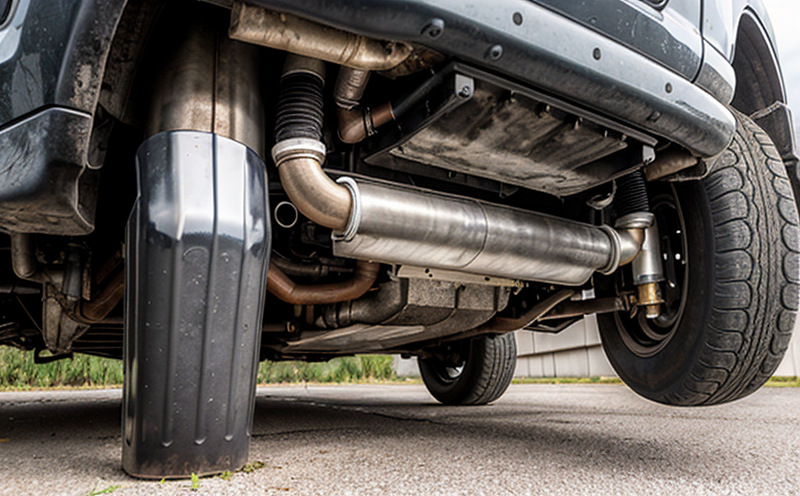Exhaust system inspection
The exhaust system in a vehicle plays an essential role in ensuring efficient engine performance, reducing emissions, and maintaining overall vehicle safety. Regular inspections of the exhaust system are critical to identify potential issues before they escalate into costly repairs or safety hazards.
In the automotive sector, the exhaust system is part of the drivetrain that includes components like mufflers, catalytic converters, pipes, and resonators. The inspection process typically involves a series of checks aimed at ensuring these components function optimally. This service ensures compliance with local regulations and international standards such as ISO 1496:2007 for muffler performance testing.
The inspection scope encompasses various aspects including the integrity of the pipes, the condition of the catalytic converter, the effectiveness of the muffler, and overall system leakage. The methodology involves a combination of visual inspections and functional tests to determine if any part requires replacement or maintenance.
For quality managers and compliance officers, ensuring that exhaust systems meet regulatory standards is paramount. This process not only aids in maintaining vehicle performance but also contributes significantly to environmental protection by reducing harmful emissions. In R&D environments, exhaust system inspections are crucial for continuous improvement in design and functionality.
The inspection process begins with a thorough visual examination of the entire exhaust system. Technicians look for signs of corrosion, cracks, or loose connections that could indicate potential issues. Following this, functional tests are conducted to check the efficiency of catalytic converters and mufflers in reducing emissions and noise respectively. These tests ensure that vehicles meet emission standards set by authorities like the Environmental Protection Agency (EPA) or similar bodies.
Accurate reporting is essential for tracking the condition of exhaust systems over time. This includes documenting any defects found during inspection, recommended actions, and a timeline for repairs. By maintaining detailed records, organizations can ensure ongoing compliance with regulatory requirements while also improving fleet performance and longevity.
The importance of regular exhaust system inspections cannot be overstated. Not only do they help maintain vehicle efficiency but also contribute to reducing harmful pollutants in the atmosphere. For R&D engineers, these inspections provide valuable feedback on design iterations and material choices used in exhaust components. Properly conducted inspections can lead to innovations that enhance both performance and sustainability.
For procurement teams, selecting suppliers who prioritize quality through rigorous inspection processes ensures reliable parts are being sourced. This not only benefits the purchasing department but also supports broader goals related to operational efficiency and environmental responsibility within an organization.
Scope and Methodology
The scope of our exhaust system inspection service covers a comprehensive evaluation of all critical components including mufflers, catalytic converters, pipes, and resonators. Our methodology follows stringent protocols to ensure accuracy and reliability in the assessment process.
- Visual Inspection: This involves examining each component for signs of damage or wear using specialized lighting equipment.
- Functional Testing: We conduct tests on mufflers and catalytic converters to measure their effectiveness in reducing noise levels and emissions respectively.
- Emission Testing: Using state-of-the-art analyzers, we assess the exhaust gases produced by vehicles during operation.
- Leak Detection: This ensures that there are no leaks within the system which could lead to increased fuel consumption or reduced engine performance.
The entire process is meticulously documented using advanced software systems. This not only helps in maintaining accurate records but also facilitates easy retrieval of information when needed.
Our team consists of certified professionals trained specifically for exhaust system inspections. They employ the latest tools and techniques to carry out these assessments effectively and efficiently.
Benefits
- Enhanced Safety: Early detection of potential issues can prevent accidents caused by faulty exhaust systems.
- Better Performance: Optimized system function leads to improved fuel efficiency and overall vehicle performance.
- Compliance Assurance: Ensures adherence to local and international emission standards, avoiding fines and penalties.
- Extended Lifespan: Regular inspections help maintain the integrity of exhaust components, extending their useful life significantly.
- Eco-Friendly Operations: By reducing emissions, it supports sustainability goals within organizations.
- Fleet Management Efficiency: Streamlined processes for tracking and managing exhaust system health contribute to better fleet management practices.
These benefits underscore the importance of regular exhaust system inspections in maintaining vehicle efficiency while promoting environmental responsibility. Proper maintenance not only extends the lifespan of vehicles but also enhances safety standards across fleets.
Industry Applications
The exhaust system inspection service finds application across various industries including automotive manufacturing, fleet management, and transportation services. In automobile manufacturing plants, this process ensures that each vehicle meets stringent quality control standards before being released to market.
Fleet managers benefit greatly from regular inspections as they help in reducing operational costs associated with repairs and replacements of faulty exhaust systems. Transportation companies operating large fleets find these inspections particularly useful for maintaining compliance with emission regulations.
In research and development laboratories, exhaust system inspections play a crucial role in testing new designs and materials used in exhaust components. This ensures that innovations are both safe and effective before being implemented widely.





